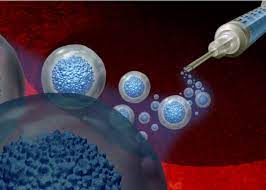Have you or a loved one been diagnosed with pulmonary fibrosis, and are looking for alternative treatments beyond traditional medicine? Look no further than stem cell therapy. Stem cells have been making headlines in the medical world as a potential treatment for various conditions, including pulmonary fibrosis. In this blog post, we will break down the benefits of stem cell therapy for pulmonary fibrosis and how it can potentially improve your quality of life. So let’s dive into the science behind this innovative treatment option!
Introduction
Pulmonary fibrosis is a condition that results in the thickening and scarring of the lungs. This can lead to difficulty breathing, fatigue, and an increased risk of infection. There is no cure for pulmonary fibrosis, but stem cell therapy may offer some hope for those with the condition.
Stem cell therapy is a type of regenerative medicine that uses stem cells to repair or replace damaged tissue. In the case of pulmonary fibrosis, stem cells may be used to help repair the damaged lung tissue. However, stem cell therapy is still in the early stages of research and more studies are needed to determine if it is effective.
Benefits of Stem Cell Therapy for Pulmonary Fibrosis
Pulmonary fibrosis is a debilitating lung condition that currently has no cure. However, stem cell therapy is showing promise as a potential treatment for pulmonary fibrosis. In this blog post, we will discuss the potential benefits of stem cell therapy for pulmonary fibrosis.
Stem cell therapy is a relatively new medical treatment that involves using stem cells to repair or replace damaged tissue. Stem cells are unique because they have the ability to self-renew and differentiate into any type of cell in the body. This makes them an ideal treatment for conditions like pulmonary fibrosis, where the lungs are damaged and need to be repaired.
There are two main types of stem cells that can be used for pulmonary fibrosis: bone marrow-derived stem cells (BMSCs) and mesenchymal stem cells (MSCs). BMSCs are the most commonly used type of stem cell for treating pulmonary fibrosis. MSCs are a newer type of stem cell that is showing promise in treating a variety of diseases, including pulmonary fibrosis.
The main benefit of stem cell therapy for pulmonary fibrosis is that it has the potential to regenerate damaged lung tissue. In one study, patients who received BMSC therapy showed significant improvement in their lung function after just one year. Additionally, another study found that patients who received MSC therapy had reduced levels of inflammation and scarring in their lungs compared to those who did not receive any treatment at all.
Different Types of Stem Cell Therapy
Pulmonary fibrosis is a progressive and debilitating lung disease for which there is currently no cure. However, stem cell therapy is emerging as a promising treatment option for pulmonary fibrosis patients. In this blog post, we’ll break down the different types of stem cell therapy and the potential benefits of each for pulmonary fibrosis patients.
There are two main types of stem cell therapy: autologous and allogeneic. Autologous stem cell therapy involves using a patient’s own stem cells, while allogeneic stem cell therapy uses donor stem cells. Both types of therapy have shown promise in treating pulmonary fibrosis.
Autologous stem cell therapy has been shown to improve lung function and quality of life in pulmonary fibrosis patients. One study showed that autologous stem cell therapy led to significant improvements in lung function and quality of life measures in a group of pulmonary fibrosis patients (1). Another study found that autologous stem cell therapy was associated with reduced decline in lung function over time in pulmonary fibrosis patients (2). Allogeneic stem cell therapy has also been shown to be effective in treating pulmonary fibrosis. One study showed that allogeneic stem cell transplantation led to significant improvements in lung function and quality of life measures in a group of pulmonary fibrosis patients (3).
The potential benefits of stem cell therapy for pulmonary fibrosis patients make it an exciting treatment option worth further exploration. If you or someone you know has been diagnosed with
Potential Risks of Stem Cell Therapy
There are a few potential risks associated with stem cell therapy for pulmonary fibrosis, including:
-Infection: There is always a risk of infection when undergoing any type of medical procedure. However, the risk of infection is relatively low with stem cell therapy and can usually be effectively treated with antibiotics.
-Bleeding: There is also a small risk of bleeding during the procedure, which can usually be controlled with medication.
-Rejection: In some cases, the body may reject the transplanted stem cells. This is more likely to occur in patients who have already had a transplant or who have a weakened immune system.
How to Access Stem Cell Treatments
There are a few ways to access stem cell treatments. One is to find a clinical trial (see our previous blog on how to search for one here). Another is to go to a center that offers stem cell therapy, which is sometimes called an “infusion center.” These centers are usually affiliated with a hospital or university medical center. You may also be able to receive stem cells from a blood or marrow transplant program.
Alternatives to Stem Cell Therapy
While stem cell therapy is a promising treatment option for pulmonary fibrosis, it is not the only option available. There are a number of other treatment options that can be considered, depending on the individual case. These include:
-Medications: There are a number of different medications that can be used to help manage the symptoms of pulmonary fibrosis and slow the progression of the disease.
-Oxygen therapy: This can help to improve quality of life by increasing the amount of oxygen in the blood.
-Surgery: In some cases, surgery may be an option to remove damaged tissue or to implant devices that can help to improve breathing.
-Lung transplant: This is often considered as a last resort option, but can be very effective in treating pulmonary fibrosis.
Conclusion
Stem cell therapy has been proven to offer a number of potential benefits for those suffering from pulmonary fibrosis. It can help reduce inflammation and improve the functioning of the lungs, as well as encourage production of new cells in the body.
Additionally, stem cell therapy is safe and minimally invasive, making it an attractive option for those looking for relief from their symptoms without having to undergo more intensive treatments such as surgery or medications. For those who are interested in exploring this form of treatment further, consulting with your doctor about whether it might be right for you is highly recommended.
Write and Win: Participate in Creative writing Contest & International Essay Contest and win fabulous prizes.
















